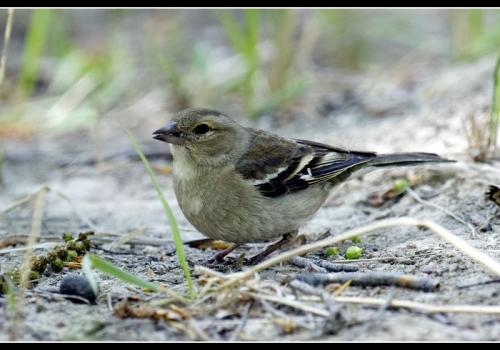(单词翻译:单击)
听力文本
This is Scientific American — 60-Second Science. I'm Jason G. Goldman.
Got a minute?
When birds face the destruction of their habitat, some species don't make it while others survive. But what happens at the very beginning of the process, just as a bird's habitat starts to change?
Research in Argentina's Monte Desert has provided some answers. Protected parts of the desert have lots of plant diversity: trees, tall shrubs, short shrubs, grasses and flowering plants. With so many options, most seed-eating birds choose to focus on large grass seeds. The birds can get all the energy and nutrients they need with minimal effort.
But when cattle show up to graze the desert's natural landscape, birds face changes in food availability. Some birds are happy to change their diets in response. But others, not so much. And it's the ones set in their ways that are at the highest risk. Understanding how birds react to grazing can help conservationists figure out how to help those species most in jeopardy.

Ecologists from the Argentine Arid Zones Research Institute compared soil samples from the desert's Ñacuñán biosphere reserve to samples from two neighboring cattle ranches. It is discovered that grass seeds—the birds' favorites—were just one-quarter as likely to be found in the ranches compared with the reserve.
Next, they captured birds and flushed their digestive tracts to see what they were eating. The Common Diuca-Finch [finch sounds] and the Rufous-Collared Sparrow [sparrow sounds] had adjusted their diets, opting to dine on their less preferred options at the ranches, even while they still focused on large grass seeds in the reserve.
Meanwhile, the Many-Colored Chaco Finch [chaco finch sounds] and the Ringed Warbling-Finch [warbling finch sounds] were apparently unable to switch their foraging tactics. Even at the ranches, they worked hard to find the few grass seeds available. If they burn more energy foraging than they get from the few seeds they find, they could starve. At best, their dietary rigidity could limit their ability to reproduce or to care for their young. The results are in the journal The Condor.
Studies like this can help predict which species are at higher risk in degraded habitats. And they can help ranchers protect these vulnerable species, even while allowing their livestock to graze. For example, the ranchers can plant species for their cattle that will also be more palatable and nutritious for local seed-eating birds. The cows won't care about the menu change—but the birds sure will.
Thanks for the minute for Scientific American — 60-Second Science Science. I'm Jason G. Goldman.
参考译文
这里是科学美国人——60秒科学。我是杰森·古德曼。
有一分钟时间吗?
鸟类的栖息地遭到破坏以后,有些物种会无法生存,而其他物种则会生存下来。但在整个过程开始时,也就是鸟类栖息地刚开始变化时发生了什么?
在阿根廷蒙特沙漠进行的研究为我们提供了一些答案。沙漠保护区的植物多样性很丰富:有乔木、高灌木、矮灌木、草地和开花植物等。面对如此多的选择,大多数以种子为食的鸟类会选择较大的草籽。这样鸟类只需付出最小的努力,就能获得它们所需的能量和营养。
但当家畜出现并以这片沙漠自然景观觅食时,鸟类开始面临食物供应的改变。有些鸟类很乐意改变食物。但是其他鸟类则不太愿意。那些是固守原有觅食习惯的鸟类,而它们的习惯风险最高。了解鸟类对放牧的反应,有助于自然资源保护者找出方法,帮助那些处于危险境地的物种。
阿根廷干旱地区研究所的生态学家将沙漠中Nacunan生物圈保护区的土壤样本与两个相邻牧场的土壤样本进行了比较。他们发现,就鸟类最爱的草籽来说,在牧场内发现的数量只有保护区的四分之一。
然后,他们捕获了几只鸟并对它们的消化道进行冲洗,目的是看看它们吃了什么。迪卡雀和红领带鹀调整了它们的饮食习惯,在牧场它们选择了次优食物,而在保护区它们依然会选择大草籽。
同时,彩雀和黑领歌鹀明显没能改变觅食策略。即使在牧场,它们也还在努力寻找数量极少的草籽。如果它们找种子所消耗的能量大于它们吃种子所获得的能量,那它们就会挨饿。即便作最乐观的估计,它们这种僵化的食谱也会限制它们的繁殖能力或扶养后代的能力。这项研究结果发表在《秃鹫》期刊上。
这类研究有助于预测退化栖息地中哪些物种面临较高的风险。还可以帮助牧场主保护这些脆弱物种,即便依旧允许他们的牲畜吃草。比如,牧场主可以种植某些植物,既可以供牛群食用,也能供当地吃种子的鸟类食用,让它们获得美味又营养的食物。牛不会在意食谱的改变,但是鸟类却会。
谢谢大家收听科学美国人——60秒科学。我是杰森·古德曼。
译文为可可英语翻译,未经授权请勿转载!
重点讲解
重点讲解:
1. be happy to do sth. 乐意的;情愿的;
例句:If it would facilitate matters, I would be happy to come to New York.
如果对事态发展有利,我很乐意来纽约。
2. in jeopardy 处于危险境地;受到威胁;
例句:This kind of ethnic rivalry is clearly a serious issue that is placing economic growth and development in jeopardy.
这种种族的敌对状态显然是一个严肃的问题,使经济的增长与发展处于危险的境地。
3. opt to do sth. 选择;作出抉择;
例句:Our students can also opt to stay in residence.
我们的学生也可以选择住校。
4. dine on 以…为正餐;
例句:My daughters could dine on caviar and champagne for the rest of their lives.
我的女儿们后半辈子可以天天吃鱼子酱、喝香槟了。
5. at best 充其量;顶多;至多;
例句:This policy, they say, is at best confused and at worst non-existent.
有人说这项政策往好里说是混乱不堪,往坏里说就是形同虚设。
我的女儿们后半辈子可以天天吃鱼子酱、喝香槟了。


